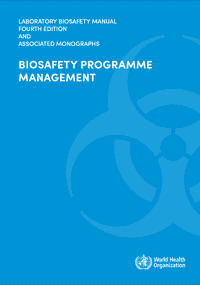LBM, 4th Edition: Biosafety Programme Management Monograph
[LBM 4: Biosafety Programme Management]
One of seven monographs associated with the 4th edition of the WHO LBM. This monograph covers biosafety program management, the process of developing and implementing biosafety oversight at the organizational level. This monograph describes the plan–do–check–act management cycle that allows a biosafety program to operate in a risk- and evidence-based way.
SUMMARY
The Biosafety programme management monograph covers biosafety program management, the process of developing and implementing biosafety oversight at the organizational level. This monograph describes the plan–do–check–act management cycle that allows a biosafety program to operate in a risk- and evidence-based way. Management is a large focus of modern biorisk assessments that allows for continuous improvement of biosafety programs and the establishment of a strong safety culture with a lab. The monograph outlines several roles and responsibilities of lab personnel within an effective biosafety management structure. The creation of this monograph was funded by Global Affairs Canada, the United States Department of State and the United States Defense Threat Reduction Agency.
This monograph was one of seven associated with the 4th edition of the WHO Laboratory Biosafety Manual (LBM).The LBM guidelines have been globally recognized as a fundamental resource for laboratory biosafety since the first edition was released in 1983. While the standards outlined in this manual are not legally binding, they have become the defacto global standard for biosafety and have inspired many national codes. These guidelines are developed with experts from around the world, and were most recently updated for the fourth edition in 2020, which places a larger emphasis on an evidence and risk based approach to biosafety and biosecurity. Previous editions of the manual have been published in 13 languages, although, as of the last time this library was updated, the 4th edition was only available in English. The development of the manual is led by the Biosecurtity and Health Security Interface at the WHO, a team who also supports national implementation efforts of the International Health Regulations and emergency preparedness.


..png)
